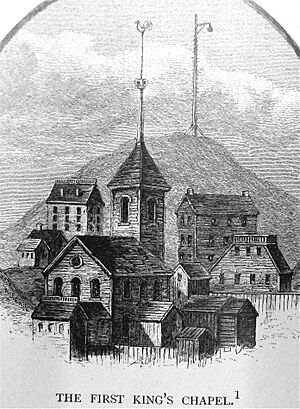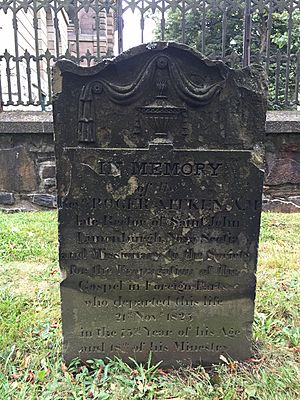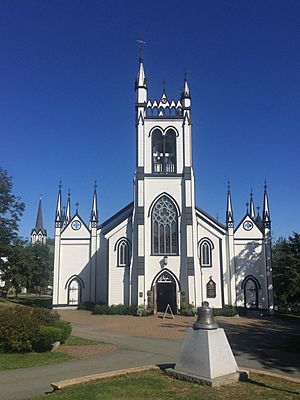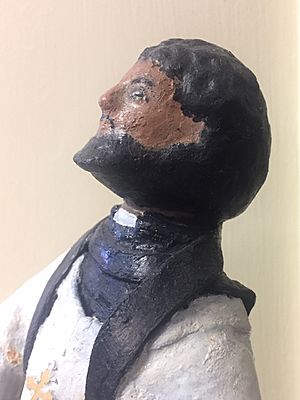St. John's Anglican Church (Lunenburg) facts for kids
St. John's Anglican Church was the very first church built in Lunenburg, Nova Scotia, Canada, back in 1754. It was the second Church of England building in Nova Scotia. It's also the second oldest Protestant church still standing in Canada today. On November 1, 2001, a fire badly damaged St. John's Church. It was carefully rebuilt and opened again on June 12, 2005.
Many of the church members were German Lutherans. The first missionary sent to the church was Reverend Jean-Baptiste Moreau (clergyman). He is buried in a special room called a crypt under the church. Dettlieb Christopher Jessen gave the church a bell, which is now on display outside. This bell was made in London by the same company that made Big Ben and the Liberty Bell. Jessen also gave the church a silver cup called a Chalice in 1814. Later, Lt. Col. Charles Edwin Kaulbach gave bells for the church tower in 1902. Reverend Roger Aitken helped set up the church's rectory (the minister's house) on Townsend Street around 1824.
Inside the church, there is a stone monument for John Creighton Sr.. This monument was made by John Bacon (1777–1859), a famous sculptor from the 1800s. He also created many monuments in important places like St Paul's Cathedral and Westminster Abbey.
Contents
The Church Building's Story

St. John's Church was built during the French and Indian War. It was made using wood from an older church building. This wood came from King's Chapel in Boston, Massachusetts. When King's Chapel was made bigger, they built a new stone church around their old wooden one. Once the new stone building was finished in 1754, the old wooden frame was taken apart from the inside. The wood was then shipped all the way to Lunenburg to build St. John's Church.
As mentioned, a fire badly damaged the church on November 1, 2001. It was rebuilt and opened again in 2005. During the rebuilding, a puzzle appeared! Many stars were painted inside the church. This mystery caught the attention of people around the world, including astronomers. It's thought that the amazing star scene might show what the night sky looked like on the very first Christmas, about 2,000 years ago, as seen from Lunenburg.
In 2005, the church gave some wood from an old church bench to the Six String Nation project. This project created a special guitar called Voyageur. Parts of the church's wood were used inside the guitar for support.
The Crypt: A Resting Place
There are 18 people buried in the crypt, which is a special burial room under the church. Seven of these people were under 17 years old. Some important people buried here include:
Founders of Lunenburg Buried Here
- Dettlieb Christopher Jessen (died 1814): He fought in the Raid on Lunenburg (1782). He also gave the church bell and the silver chalice. His wife, Francisca Barbara (Rudolf) Jessen (died 1807), is also buried here.
- John Creighton Sr. (died 1806): He also fought in the Raid on Lunenburg (1782).
- Honorable Sebastian Zouberbuhler (died 1773): He fought in the Siege of Louisbourg (1745). He became one of the first three Justice of the Peace officials in Lunenburg, along with John Creighton and Patrick Sutherland.
- Reverend Jean-Baptiste Moreau (clergyman) (died 1770): He was the church's first minister.
Other People in the Crypt
- Reverend Paulus Bryzelius (died 1773): A minister.
- Reverend Thomas Shreve (died 1816): A minister and soldier during the American Revolution.
- John Creighton Jr. (died 1826).
- Honorable Francis Joseph Rudolf (died 1823).
- William (died 1776): The one-year-old son of Reverend Peter de la Roche.
- Miss Margaret Cheyne (1748-1821).
Early Ministers of the Church

Here are some of the early ministers who served St. John's Church:
- Reverend Jean-Baptiste Moreau (1753-1770)
- Reverend Robert Vincent (clergyman) (1762-1765)
- Reverend Paulus Bryzelius (1768-1773)
- Reverend Peter de la Roche (1771-1787): He signed a ransom agreement with American privateers during the Raid on Lunenburg (1782). He later became the first Anglican minister in Guysborough, Nova Scotia.
- Reverend Richard Money (1787-1803)
- Reverend Thomas Shreve (1804-1816)
- Reverend Roger Aitken (1817-1825)
- Reverend James Cuppaidge Cochran (1825-1852): He helped start the Halifax School for the Deaf.
Images for kids
-
The monument for John Creighton Sr. by John Bacon in London.
-
Governor Michael Francklin's Bible from 1765. It was first owned by Rev. Robert Vincent, the second minister of St. John's.
-
Jessen gave St. John's these silver items: a chalice, a flagon, and a paten in 1814.











